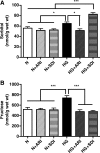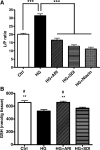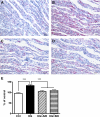Cardiac contractile dysfunction during acute hyperglycemia due to impairment of SERCA by polyol pathway-mediated oxidative stress
- PMID: 20573996
- PMCID: PMC2944313
- DOI: 10.1152/ajpcell.00137.2010
Cardiac contractile dysfunction during acute hyperglycemia due to impairment of SERCA by polyol pathway-mediated oxidative stress
Abstract
Hyperglycemia is an indication of poor outcome for heart attack patients, even for nondiabetic patients with stress-induced hyperglycemia. Previous studies showed that inhibition of aldose reductase, the first and rate-limiting enzyme of the polyol pathway, attenuated contractile dysfunction in diabetic animals, but the mechanism is unclear. We therefore wanted to find out whether the polyol pathway also contributes to acute hyperglycemia-induced cardiac contractile dysfunction, and determine the mechanism involved. Rat hearts were isolated and retrogradely perfused with Krebs buffer containing either normal or high concentrations of glucose for 2 h. Short exposure to high-glucose medium led to contractile dysfunction as indicated by decreased -dP/dt(max), as well as elevation in left ventricular end-diastolic pressure. Cardiomyocytes incubated in high-glucose medium showed abnormal Ca2+ signaling, most likely because of decreased activity of sarco(endo)plasmic reticulum Ca2+-ATPase (SERCA) inactivated by oxidative stress. Inhibition of aldose reductase or sorbitol dehydrogenase, the second enzyme in the polyol pathway, ameliorated contractile dysfunction, attenuated oxidative stress, and normalized Ca2+ signaling and SERCA activity caused by high glucose, indicating that the polyol pathway is the major contributor to acute hyperglycemia-induced oxidative stress leading to the inactivation of SERCA and contractile dysfunction.
Figures







Similar articles
-
Polyol pathway impairs the function of SERCA and RyR in ischemic-reperfused rat hearts by increasing oxidative modifications of these proteins.J Mol Cell Cardiol. 2010 Jul;49(1):58-69. doi: 10.1016/j.yjmcc.2009.12.003. Epub 2009 Dec 16. J Mol Cell Cardiol. 2010. PMID: 20025885 Free PMC article.
-
Cardiac contractile dysfunction in Lep/Lep obesity is accompanied by NADPH oxidase activation, oxidative modification of sarco(endo)plasmic reticulum Ca2+-ATPase and myosin heavy chain isozyme switch.Diabetologia. 2006 Jun;49(6):1434-46. doi: 10.1007/s00125-006-0229-0. Epub 2006 Apr 13. Diabetologia. 2006. PMID: 16612592
-
Oxidative posttranslational modifications mediate decreased SERCA activity and myocyte dysfunction in Galphaq-overexpressing mice.Circ Res. 2010 Jul 23;107(2):228-32. doi: 10.1161/CIRCRESAHA.110.217570. Epub 2010 May 27. Circ Res. 2010. PMID: 20508180 Free PMC article.
-
Hyperglycemia-induced cardiac contractile dysfunction in the diabetic heart.Heart Fail Rev. 2018 Jan;23(1):37-54. doi: 10.1007/s10741-017-9663-y. Heart Fail Rev. 2018. PMID: 29192360 Review.
-
Calcium regulatory proteins and their alteration by transgenic approaches.Am J Cardiol. 1999 Jun 17;83(12A):89H-91H. doi: 10.1016/s0002-9149(99)00268-4. Am J Cardiol. 1999. PMID: 10750595 Review.
Cited by
-
Glucose regulation of load-induced mTOR signaling and ER stress in mammalian heart.J Am Heart Assoc. 2013 May 17;2(3):e004796. doi: 10.1161/JAHA.113.004796. J Am Heart Assoc. 2013. PMID: 23686371 Free PMC article.
-
Rescuing SERCA2 pump deficiency improves bone mechano-responsiveness in type 2 diabetes by shaping osteocyte calcium dynamics.Nat Commun. 2024 Jan 30;15(1):890. doi: 10.1038/s41467-024-45023-6. Nat Commun. 2024. PMID: 38291059 Free PMC article.
-
Is the lack of adiponectin associated with increased ER/SR stress and inflammation in the heart?Adipocyte. 2014 Jan 1;3(1):10-8. doi: 10.4161/adip.26684. Epub 2013 Oct 9. Adipocyte. 2014. PMID: 24575364 Free PMC article.
-
Cardiac dysfunction and oxidative stress in the metabolic syndrome: an update on antioxidant therapies.Curr Pharm Des. 2013;19(27):4806-17. doi: 10.2174/1381612811319270003. Curr Pharm Des. 2013. PMID: 23323621 Free PMC article. Review.
-
Acute hyperglycaemia does not have a consistent adverse effect on exercise performance in recreationally active young people with type 1 diabetes: a randomised crossover in-clinic study.Diabetologia. 2021 Aug;64(8):1737-1748. doi: 10.1007/s00125-021-05465-9. Epub 2021 May 4. Diabetologia. 2021. PMID: 33944971 Clinical Trial.
References
-
- Adachi T, Matsui R, Xu S, Kirber M, Lazar HL, Sharov VS, Schoneich C, Cohen RA. Antioxidant improves smooth muscle sarco/endoplasmic reticulum Ca(2+)-ATPase function and lowers tyrosine nitration in hypercholesterolemia and improves nitric oxide-induced relaxation. Circ Res 90: 1114–1121, 2002 - PubMed
-
- Adachi T, Weisbrod RM, Pimentel DR, Ying J, Sharov VS, Schoneich C, Cohen RA. S-glutathiolation by peroxynitrite activates SERCA during arterial relaxation by nitric oxide. Nat Med 10: 1200–1207, 2004 - PubMed
-
- Bassenge E, Sommer O, Schwemmer M, Bunger R. Antioxidant pyruvate inhibits cardiac formation of reactive oxygen species through changes in redox state. Am J Physiol Heart Circ Physiol 279: H2431–H2438, 2000 - PubMed
-
- Bers DM. Calcium fluxes involved in control of cardiac myocyte contraction. Circ Res 87: 275–281, 2000 - PubMed
-
- Bowes J, McDonald MC, Piper J, Thiemermann C. Inhibitors of poly (ADP-ribose) synthetase protect rat cardiomyocytes against oxidant stress. Cardiovasc Res 41: 126–134, 1999 - PubMed
Publication types
MeSH terms
Substances
Grants and funding
LinkOut - more resources
Full Text Sources
Medical
Miscellaneous

